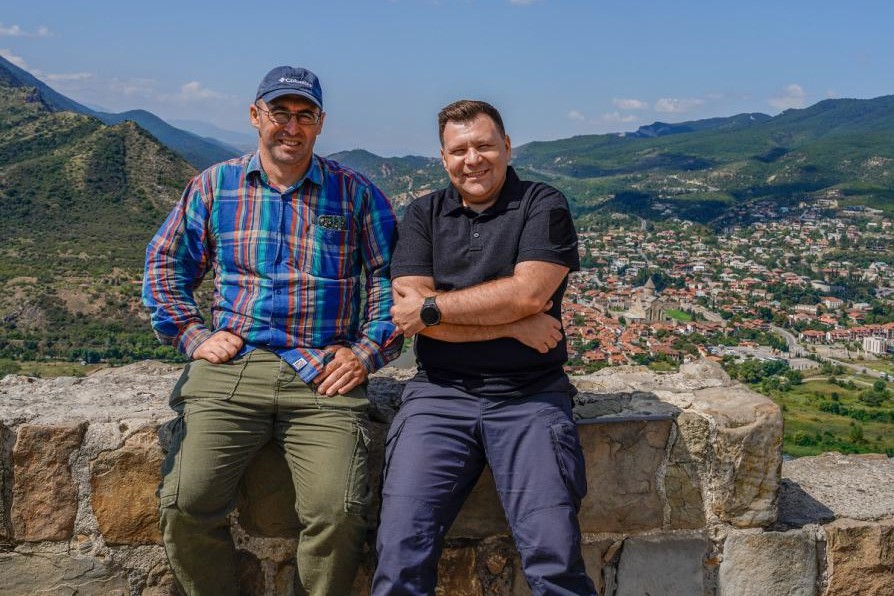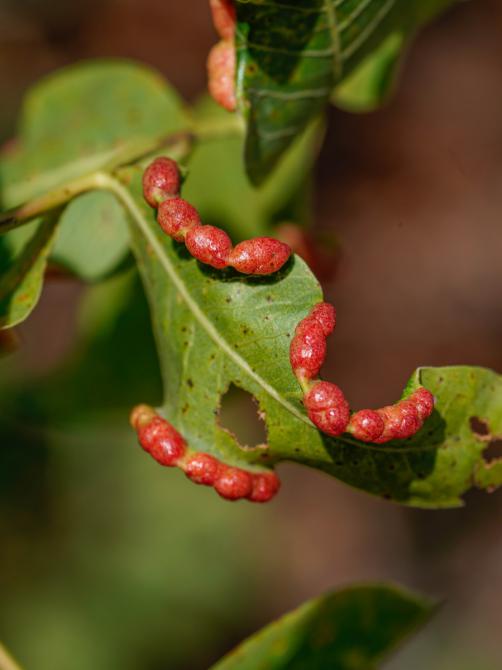| Małgorzata Kłoskowicz PhD |
Aphids can be found virtually everywhere on Earth. On the one hand, they live in quite well-known centres of biodiversity, in the Himalayas, Japan and the Mediterranean basin. On the other hand, they can still be found in poorly explored places on the world map, such as Bhutan – a country in South Asia almost entirely covered with forests. Aphidologists therefore cooperate with local enthusiasts to obtain traces of unfamiliar fauna, or they set off on a journey themselves. Mariusz Kanturski, PhD, Assoc. Prof. from the Faculty of Natural Sciences returned from one of such expeditions a few months ago. He examined the species structure of Caucasus aphids in selected plant locations in Georgia.
“It’s hard to compare field work to anything else. It is best to observe aphids in their natural habitat. This is not always possible, so often the main source of information is material sent by people I have been working with for years. There is one problem, however. These are dead aphids”, says Mariusz Kanturski, PhD, Assoc. Prof. and immediately draws attention to an interesting detail. “Imagine having to estimate the value of a shipment of aphids that have sacrificed their lives for science. The market value is practically zero, but for a researcher they are priceless. So, it’s better to hit the road and take a closer look at the aphids we are interested in, in their natural surroundings”, he adds.
When an expedition is not possible, you need good relationships with experts from around the world. They obtain material for analysis in due time. Prof. Mariusz Kanturski gives the example of Minho Lee, a PhD student of Prof. Seunghwan Lee from Seoul National University in Korea, who is hugely fascinated by aphids.
“In him I see myself at the beginning of my scientific path. I enjoy working with him a lot. For example, Minho observed the leaf galls that are formed by Tuberaphis takenouchi, a species of foreign origin in Korea. Throughout the year, he regularly travelled to Jeju Island to document how this growth changed over time. The better we understand this process, the more we will learn about the aphid species we are interested in”, says the researcher from the University of Silesia.
He also recalls cooperation with Masahisa Miyazaki, PhD from Japana, a retired, distinguished aphidologist:
“Our relationship was quite rough at the beginning. I suppose that I received research material from him only because I was on an internship in London with Roger Blackman, PhD. When I sent the material back, I packed it carefully and prepared a note summarising my analysis. This somehow warmed up our relationship. Miyazaki, PhD spent more than a year looking for aphids from a genus and species new to science, feeding on cherry tree branches”. The researcher from the University of Silesia admits that it was not an easy task due to the unique… camouflage. Aphids of this species are covered with lumps of earth that ants stick to them to better protect the insects against their natural enemies. Patience of Miyazaki, PhD paid off. The cooperation resulted in acquiring full knowledge of the biology of this species of aphids from the Lachninae subfamily.
A common passion for science often becomes the beginning of a long-term friendship, and a research trip seals it.
“Field work is, of course, important, but it is worth adding that during such trips I am invited to the homes of my fellow scientists. I spend a lot of time with them and their families. It is then easier to conduct research together and you can get to know another country better. Although I must admit that in this group it is difficult to expect topics other than those related to the life of aphids to be discussed”, the scientist comments with a laugh.
No wonder that instead of waiting for the next package of microscopic slides, Prof. Mariusz Kanturski happily went for a changed od scenery and flew to Georgia to study aphids living in the Caucasus. He hiked with his guides, also researchers, to a height of over 3,000 m above sea level and combed through the residual vegetation present there in search of insects that he was interested in. Among the small plants, in their roots, he finally noticed aphids. The feeling of satisfaction quickly gave way to scientific curiosity. The aphidologist checked, among other things, whether the place of their feeding caused any changes in the plants and whether there was any interaction with other insects, most often ants.
Shalva Barjadze, PhD from Ilia State University in Tbilisi and Mariusz Kanturski, PhD, Assoc. Prof. from University of Silesia against the background of Mtskheta, the first capital city of Georgia | private archive
“These ants are really important. My colleague from the University of Silesia, Łukasz Depa, PhD, DSc, Assoc. Prof., who, like me, deals with aphids, once suspected that he was dealing with two different species of aphids only because he observed different species of ants nearby”, says the researcher.
You can also learn a lot by observing the plants on which aphids feed. There are species whose entire life cycle takes place on only one plant species, but there are also species that, like humans, prefer changes in the place of development and feeding. For example, in spring, the founder of the family hatches from an egg on a selected tree species. There, winged morphs appear and then migrate to the secondary host, where only single-sex, i.e. parthenogenetic, reproduction takes place. In late summer, either the mother of the hermaphrodite generation appears on the secondary host and returns to the primary host, or the mother of oviparous females and a winged male appear. Together they return to the original host, where copulation and egg laying take place.
Typically, in this type of migration, as the aphidologist explains, a tree or shrub is switched to an herbaceous plant. Migration from tree to tree would be an interesting novelty then, but it has already been observed in nature.
“This would apply, for example, to my beloved subfamily Lachninae. Japanese scientists have already signalled that this is the case with one species of the genus Stomaphis, as well as the genus Nippolachnus I am studying”, says the researcher.
Plants in general are an important clue in the work of an aphidologist. For example, during a trip to Georgia, Prof. Mariusz Kanturski became interested in the local cedars.
“I acted as an external consultant in the project of Shalvy Barjadze, PhD from Ilia State University. My goal was to study the biodiversity of Caucasus aphids in selected plant locations in Georgia. I knew, among other things, that there were a lot of cedars there. I was curious whether I would encounter Cinara cedri aphids, a quite serious pest of this tree species”, says the scientist. “My intuition did not fail me. When I entered the park in the city centre, I saw stains on the steps, as if someone had sprayed oil on them. These are aphids. Above me are cedars, and on the cedars are thousands of aphids. They were accompanied, surprisingly, not by ants but by wasps. A short observation was enough to make sure that it was worth continuing research there and modelling the potential occurrence of this species”, emphasises the aphidologist.
Such expeditions do not always have to end in success. Sometimes you simply cannot find an interesting specimen. Still, you need to keep your eyes wide open when traveling.
“I’m not the only one waiting for research material. There are some species of aphids that do not interest me at all. For example, the genus Aphis. There is no scientific chemistry between us. If I passed by it, I wouldn’t collect a single aphid for my collection, but I know that there are fellow aphidologists who conduct research on this genus, and I take a few specimens with them in mind”, says the researcher. “Do I find collecting specimens easy? Of course not. I know that aphids sacrifice their lives for our knowledge. Immersing them in ethyl alcohol makes them die instantly, but I still don’t like this process. Each time I assess how many aphids are needed for research, so as not to kill more insects than necessary”, emphasises the scientist.
As he adds, there is something of old-style science in this kind of research. Prof. Mariusz Kanturski admits that in his opinion this applies to all entomologists. Basic research methods have not changed practically since the 19th century, although researchers have modern equipment at their disposal. However, their work is based on patience and attention to detail from the very beginning. They are motivated to act by the thought that somewhere out there there are still undiscovered species and types of insects, for which it is worth devoting their time and going on a journey, even to the end of the known world.
Article ‘Insects that have taken over the entire world’ was published in the February issue of University of Silesia Magazine No. 5 (315).
Galls formed by aphids feeding on pistachio leaves (each gall contains live specimen) | Mariusz Kanturski







